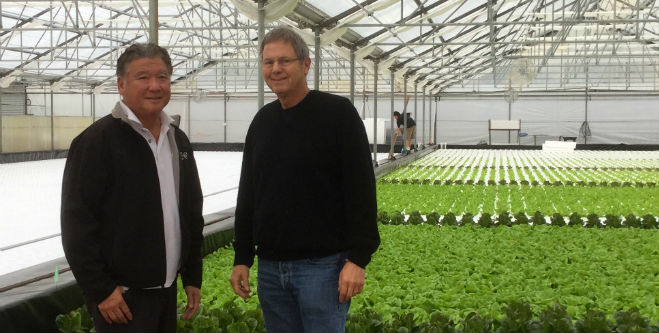
Jul 26, 2017Suncrest USA doing lettuce the hydroponic way
Suncrest USA is putting its best foot forward to become a leader in sustainable hydroponic growing technology, ramping up production in Silicon Valley to meet what the company said is strong demand from restaurants and grocers for its locally grown leafy greens.
In just a few years, San Francisco-based Suncrest has progressed from an angel-backed pilot project operating in “stealth mode” to a 1.25-acre scaled-up greenhouse operation “with dozens of marquee customers and proven technology.” To date, it has signed licensees in two key markets: Seattle and the San Francisco Bay Area, and is gearing up for operations in 40 U.S. markets.
“With strong sales volume and brand recognition for Suncrest lettuce in the San Francisco Bay Area, we are now looking to add more growers to our family of licensees,” said Jim Day, founder and CEO, Suncrest USA. “For the moment, we are focused on West Coast markets, but we expect to be on the East Coast in just a few more years.”

Day was part of a panel in May at the Silicon Valley AgTech Conference in Mountain View, California.
“Suncrest is changing the way food is grown by licensing its advanced hydroponic technology to greenhouse growers so they can cater to strong and growing consumer demand for year-round, locally grown lettuce and leafy greens,” Day told Vegetable Growers News.
He said the transformational business model works to turn around struggling local greenhouse operations.
Suncrest’s patent-pending, deep-water culture (DWC) hydroponic systems enable local greenhouse growers, some of whom Day said are struggling financially, to transform their underperforming greenhouses (many in the cut flower industry) into “high-value, high-volume, year-round production facilities.”
Suncrest then cross-trains the grower, purchases most of the production, and develops local marketing, sales and distribution techniques.
The company’s first licensee was a small greenhouse operator on Whidbey Island, north of Seattle. Initially established as a pilot project and proof of concept for Suncrest’s investors, the operation is now run by Suncrest subsidiary Whidbey Growers as an R&D operation to test varieties and technology for Suncrest’s larger licensees. With its “licensing model established, and with demand already strong for its high-quality lettuce,” Day said Suncrest went after its next major milestone – a scaled-up operation.
In 2015, Suncrest identified the San Francisco Bay Area, with its persistent drought and obsession with high-quality local produce, as its next beachhead, Day said.
Earlier this year, Suncrest entered what Day called a key phase of its growth with the completion of a 55,000-square-foot pilot with Oku, of Pescadero, California, a family-owned cut flower operation established in 1902.
“With 440,000 square feet of greenhouse space, Oku represents the perfect licensing partner since South American flower imports have eaten into its profits,” Day said.
The initial Oku-owned Suncrest operation, called Pescadero Growers, is a 55,000-square-foot DWC hydroponic lettuce operation. With the help of Suncrest’s marketing and distribution expertise, Day said, Pescadero Growers is repositioning itself to become a major player in the new, local, sustainable agriculture movement.
Day said Suncrest has established a local market for Pescadero Growers by signing up premium grocers and upscale restaurants such as Chez TJ (Michelin Star), Epic Steak House, Lexington House, Madera on Sand Hill (Michelin Star), Monsieur Benjamin, Parcel 104, Sharon Heights and Los Altos Country Clubs, Tender Greens, The Fairmont San Francisco, The Ritz Carlton (San Francisco and Half Moon Bay), Woodside Village Pub and Zume Pizza in the Bay Area. Meanwhile, retailers such as Bianchini’s Markets, Robert’s Market of Woodside, and Sigona’s Markets are now offering Pescadero Growers lettuces.
“In the past, when we grew flowers, it was food for the soul,” said Steve Oku, owner of Pescadero Growers, and former president of the San Francisco Flower Mart, said in a news release. “But now, we are also growing food for the body – we are now nurturing both body and soul.”
Day said the recent persistent and strong rains, and shorter growing season in Arizona and California have led to shortages of several crops, including lettuce. And with production constrained, wholesale prices have been rising.
Pescadero Growers’ large hydroponic tanks, where the lettuce floats on nutrient-rich rafts, can produce nearly 1 million heads of lettuce per year. But after an expansion currently underway, it will be closer to 2.25 millions heads per year, Oku said.

Currently, most of the volume is Bibb lettuce, Red Romaine and Green Romaine. Now that Suncrest has completed year-round greenhouse production at scale, and has demonstrated an ability to build brand and win customers, Day said the company is looking for its next scale-up location.
“Sustainable, indoor ag tech has come into its own as an industry,” Day said. “What differentiates Suncrest is its scalable licensing model that not only includes turnkey hydroponic systems, but also builds brand and market share within each local market. This is the best of all worlds for the grower: they can now grow a branded product rather than a commodity, using tools and techniques that substantially increase their revenues and profit per square foot.”
Hydroponics is significantly more environmentally friendly than field-grown lettuce, Day said. For example, it takes 16-38 gallons of water to grow a single head of lettuce in the field, but only one gallon using hydroponics.
According to USDA, field yields for field-grown lettuce are only about 0.4 heads per square foot, compared with 25-plus heads per square foot in hydroponics. Day said this is due to packing density and the number of growth cycles per year in a greenhouse. And by using a local distribution model, there is zero carbon footprint due to long-haul distribution.
— Gary Pullano, managing editor
















